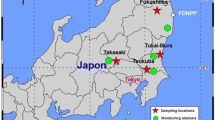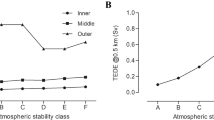Abstract
In several hours of a calm meteorological situation, a relatively significant level of radioactivity may accumulate around the source. When the calm situation expires, a wind-induced convective movement of the air immediately begins. Random realisations of the input atmospheric dispersion model parameters for this CALM scenario are generated using Latin Hypercube Sampling scheme. The resultant complex random radiological trajectories, passing through both calm and convective stages of the release scenario, represent the necessary prerequisite for the prospective uncertainty analysis (UA) and the sensitivity analysis (SA). The novel approximation-based (AB) solution replaces the non-Gaussian sum of individual puffs at the end of the calm period with one Gaussian “super-puff” distribution. This substantially accelerates generation of a sufficiently large number of random realisations for the radiological trajectories, thus facilitating the subsequent UA and SA. Both of these procedures exploit a common mapping between the pairs of calculated output fields on the one hand and the realisation vectors of the associated random input parameters on the other hand. This paper presents the necessary technical background, as well as the idea of the AB solution and its use. Examples of 2-D random trajectories of deposited 137Cs are presented in a graphical form. Global sensitivity analysis based on random sampling methods is outlined and improved feasibility o f the originally long-running computation is demonstrated.








Similar content being viewed by others
Notes
As said in the Introduction, the used algorithm for a Gaussian puff model, Adriaensen (2002), with the plume-segmented modification, was selected here for demonstration purposes only. In reality, more sophisticated dispersion codes are assumed to be applied. Their complexity and computational load could be diminished by the positive effect of the approximation-based (AB) procedure.
Someone may object why the input parameter of the total inventory of radionuclide was not considered as random. This factor is assumed to enter separately at a higher level procedure of inverse modelling for estimation of the source term. The problem was addressed, e.g. in Pecha and Šmídl (2016), and requires real measurements from the monitoring networks.
References
Adriaensen S, Cosemans S, Janssen L and Mensink C (2002): PC-Puff: A simple trajectory model for local scale applications. In: Berbia CA (ed) Risk analysis III. ISBN 1-85312-915-1.
Bangotra P, Sharma M, Mehra R, Jakhu R, Singh A, Gautam AS, Gautam S (2021) A systematic study of uranium retention in human organs and quantification of radiological and chemical doses from uranium ingestion. Environ Technol Innov. https://doi.org/10.1016/j.eti.2021.101360
Bernardo J (1979) Expected Information as Expected Utility. Ann Stat 7:686–690
Carruthers DJ, Weng WS, Hunt JRC, Holroyd RJ, McHugh CA and Dyster SJ (2003) PLUME/PUFF spread and mean concentration - Module specifications. ADMS4 paper P10/01S/03, P12/01S/03
ECC-MOD: Sensitivity analysis of models https://ec.europa.eu/jrc/en/samo, update 10/02/20
EPA (2004) AERMOD: Description of Model Formulation. U.S. Environmental Protection Agency, Research Triangle Park, NC (Report EPA-454/R-03–004)
Evangeliou N, Hamburger T, Cozic A, Balkanski Y, Stohl A (2017) Inverse modelling of the Chernobyl source term using atmospheric concentration and deposition measurements. Atmos Chem Phys 17(14):8805–8824
Ferretti F et al (2016) Trends in sensitivity analysis practice in the last decade. Sci Total Environ 568:666–670. https://doi.org/10.1016/j.scitotenv.2016.02.133
HARP: HAzardous Radioactivity Propagation (2010–2021) - Program system for modelling of radioactivity propagation into the living environment. https://havarrp.utia.cas.cz/harp/
Helton JC, Johnson JD, Sallabery CJ and Storlie CB (2006) Survey of sampling-based methods for uncertainty and sensitivity analysis. SANDIA report SAND2006–2901, 2006
Hershey JR, Olsen PA (2007) Approximating the Kullback Leibler divergence between Gaussian mixture models, ICASSP '07, Honolulu, HI, IV-317-IV-320
Humby DM (1994) A review of techniques for parameter sensitivity analysis of environmental models. Environ Monit Assess 32:135–154
Hutchinson M, Hyondong O, Wen-Hua C (2017) A review of source term estimation methods for atmospheric dispersion events using static or mobile sensors. Inf Fusion 36:130–148
Hyojoon J, Misun P, Wontae H, Enuhan K, Moonhee H (2013) The effect of calm conditions and wind intervals in low wind speed on atmospheric dispersion factors. Ann Nucl Energy 55:230–237
Kahl JDW, Chapman HL (2018) Atmospheric stability characterization using the Pasquill method: a critical evaluation. Atmos Environ 187:196–209
Kárný M, Guy TV (2012) On support of imperfect Bayesian participants. Decis Mak Imperfect Decis Makers. https://doi.org/10.1007/978-3-642-24647-0
Kullback S, Leibler R (1951) On information and sufficiency. Ann Math Stat 22:79–87
McLachlan GJ, Peel D (2000) Finite mixture models. Wiley, Hoboken
Pandey G, Sharan M (2019) Accountability of wind variability in AERMOD for computing concentrations in low wind conditions. Atmos Environ 202:105–116
Pecha P, Kárný M (2021) Novel simulation technique of harmful aerosol substances propagation into the motionless atmosphere suddenly disseminated by wind to surrounding environment. Ann Nucl Energy. https://doi.org/10.1016/j.anucene.2021.108686
Pecha P, Šmídl V (2016) Inverse modelling for real-time estimation of radiological consequences in the early stage of an accidental radioactivity release. J Environ Radioact 164(1):377–394
Pecha P, Tichý O, Pechová E (2021) Determination of radiological background fields designated for inverse modelling during atypical low-wind speed meteorological episode. J Atmos Environ 246:118105
Pecha P, Hofman R (2007) Integration of data assimilation subsystem into environmental model of harmful substances propagation. In: Carruthers DJ (Ed.), Proc. 11th Int Conf on Harmonisation within Atmospheric Dispersion Modelling, 111–115, Cambridge, GB
Pecha P, Pechova E (2005) Modeling of random activity concentration fields in air …. HARMO10 Conf., Sissi (Crete),Greece, October 17–20, 2005, paper No. H11–069
Pianosi F, Beven K, Freer J, Hall JW, Rougier J (2016) Sensitivity analysis of environmental models: a systematic review with practical workflow. Environ Model Softw 79:214–232
Rakesh PT, Venkatesan R, Srinivas CV, Baskaran R, Venkatraman B (2019) Performance evaluation of modified Gaussian and Lagrangian models under low wind speed: a case study. Ann Nucl Energy 133:562–567
Razavi S, Gupta HV (2015) What do we mean by sensitivity analysis? The need for comprehensive characterization of “global” sensitivity in earth and environmental systems models. Water Resour Res 51:3070–3092
Saltelli A, Annoni P (2010) How to avoid a perfunctory sensitivity analysis. Environ Modell Softw 25(12):1508
Saltelli A, Chan K, Scott EM (2001) Sensitivity analysis. John Wiley & Sons Ltd., Hobooken
Saltelli A, Annoni P, Azzini I, Campolongo F, Ratto M, Tarantola S (2010) Variance based sensitivity analysis of model output. Design and estimator for the total sensitivity index. Comp Physics Communications 181:259–270
Saltelli A, Aleksankina K, Becker W, Fennell P, Ferretti F, Holst N, Sushan L, Wu Q (2019) Why so many published sensitivity analyses are false? A systematic review of sensitivity analysis practices. Environ Model Softw 114:29–39
Sarrazin F, Pianosi F, Wagener T (2016) Global sensitivity analysis of environmental models: convergence and validation. Environ Model Softw 79(2016):135–152
Zannetti P (1990) Air pollution modeling. theories, computational methods and available software. ISBN 1 – 85312–100–2
Acknowledgements
The authors are grateful to the IT department of the National Radiation Protection Institute in Prague for free access to the archives of the historical meteorological data. The research of MK was partially supported by MŠMT ČR LTC18075 and EU-COST Action CA1622. Dr. T.V. Guy provided us a useful feedback on the presentation way.
Author information
Authors and Affiliations
Corresponding author
Additional information
Publisher's Note
Springer Nature remains neutral with regard to jurisdictional claims in published maps and institutional affiliations.
Appendix
Appendix
Demonstration of the “super-puff” concept (AB solution), see Pecha and Kárný (2021).
The CALM scenario ranks among the worst-case episodes of Weather Variability Assessment. Let total inventory \(Q_{TOT}^{n}\) = 6.0 E + 07 [Bq] of radionuclide 137Cs be discharged into the motionless ambient air during the calm conditions lasting TCALM = 5 [h], \(T^{CALM} = \left( {T_{END}^{CALM} - T_{START}^{CALM} } \right)\) . The release is modelled as a sequence of M instantaneous discrete discharges, the first (oldest puff) for m = 1 at time\(T_{START}^{LEAK}\) , the last for m = M at time \(T_{END}^{LEAK}\) . The release propagates from the elevated point source of pollution at a height of H (x = 0; y = 0; z = H) over the terrain. The radioactivity progresses during the calm episode time interval \(\left\langle {T_{START}^{LEAK} ;\;T_{END}^{CALM} } \right\rangle\). The chain of consecutive discrete puffs \(Q_{m}^{n}\) of 137Cs, m ∈ {1,…,M}, are ejected stepwise with the time periods Δtm. The release-source strength \(Q_{TOT}^{n}\) /M is initially assumed to be constant within the entire calm episode. After five hours of the calm episode, the wind begins to blow. The convective transport of the radioactivity clew immediately arises. We trace the drifting over the terrain in the next four hours. Meteorological records are extracted from stepwise forecast series for the given point of radioactive release. Hourly meteorological data of the convective transport immediately following the five hour calm episode are shown in Table
1.
Each puff reflects a partial discharge of the radioactivity \(Q_{m}^{n}\), m ∈ {1,…,M}, which dissipates into the motionless ambient atmosphere just until to the calm-period termination. The results of current realistic calm scenario in STAGE I (related to \(T_{END}^{CALM}\)) are displayed in Fig.
9. Radioactivity concentrations of 137Cs in air (in the height H) for each individual puff m are shown here. The sharpest shape for the “youngest” puff m = 99, the flattened shape for the “oldest” m = 30, has been expected. The red curve shows, clearly non-Gaussian, shape of the puffs’ superposition.
The radiological results transformed into radioactivity concentration values of 137Cs deposited on the ground at the end of the STAGE II (just after 9 h from the same beginning of the CALM start) are shown in Fig.
10. It represents the peripheral distribution (around the angular beam of the computational grid containing maximum values of deposited radioactivity) on the concentric circle c* (~ 25 [km] around the release point (of the computational grid). The results confirm a good agreement of both compared solutions in the domains of interest (with potential high values of harmful effect on the population). Several variants have been successfully tested including nonlinear releasing, serrated form, the dependency of AB approximation on the number of puffs M, etc.
Rights and permissions
About this article
Cite this article
Pecha, P., Kárný, M. A new methodology is outlined and demonstrated on the improvement of uncertainty and sensitivity analysis based on the random sampling method. Stoch Environ Res Risk Assess 36, 1703–1719 (2022). https://doi.org/10.1007/s00477-021-02110-0
Accepted:
Published:
Issue Date:
DOI: https://doi.org/10.1007/s00477-021-02110-0






